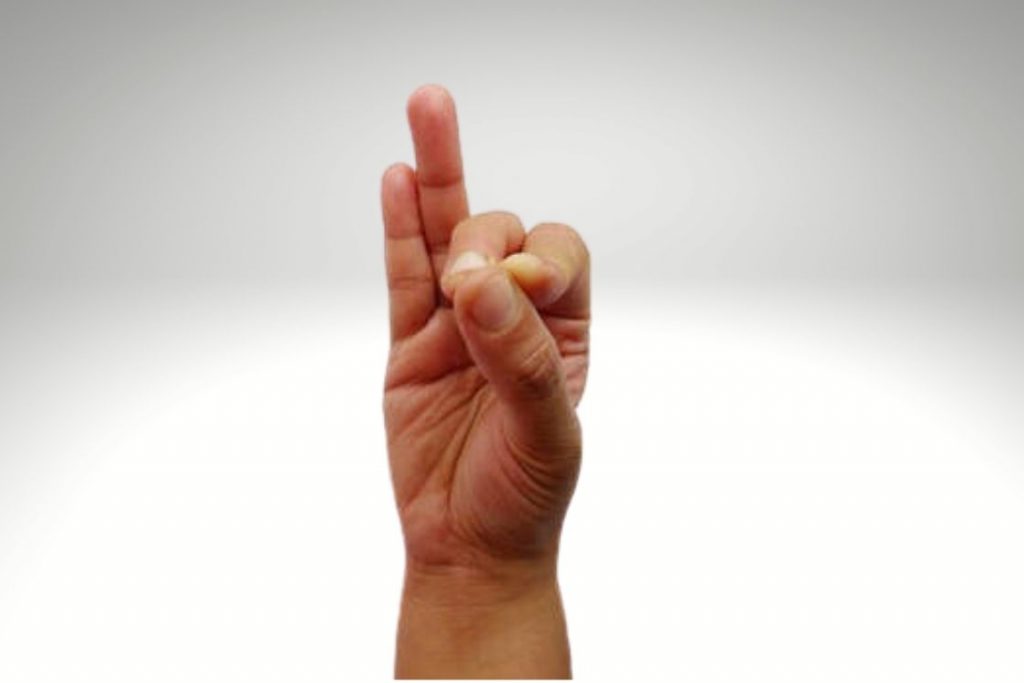
Vyana is one of the 5 vital air, also known as Prana Vayus in the body, which means “outward-moving air.”
The vyana mudra is practised to correct the imbalances in vyana vayu. It includes the distribution of nutrition, oxygen and blood supply in the body.
Vyana mudra works on cardiac activity, circulation and the voluntary nervous system. You can do vyana mudra to maintain blood pressure, mind freshness, excessive sweating and balance of Vata dosha.
In this article, we will know how to practice vyana mudra and what are its benefits.
What is Vyana Mudra?
The vyana mudra is an easy to perform hand mudra which will help in balancing the vyana vayu as well as 3 out of 5 elements of the body i.e. Pancha tattva. Since this mudra is directly concerned with balancing the blood circulation, it is also sometimes referred to as Mudra for Blood Circulation.
To perform this vyana mudra, you join the tips of the thumb, index, and middle finger while keeping the other fingers straight.
As per Ayurveda, each finger is connected to an element that makes up our body. The thumb represents fire, the index finger is air and the middle finger is for space or ether. Because vyana mudra brings index and middle finger in touch with the thumb, thus it helps balance the 3 elements; fire, air and space. When air and space element are joined, it makes Vata dosha, hence vyana mudra cures the symptoms of Vata dosha imbalance.
Vyana mudra is extremely beneficial for people with high blood pressure as it is one of the major causes of an imbalanced vyana vayu. And by balancing the space, you can also be relieved of many mental ailments.
Vyana mudra is also related to the Sacral Chakra or Swadhisthana, which is the seat of creativity, intuition and creative expression.
How to Do Vyana Mudra
Since Vyana mudra is related to Vata dosha and a balanced Vata means stable mind, this mudra can be adopted for meditation practice. It enhances the concentration power.
To perform vyana mudra, you join the tips of the thumb, index, and middle finger altogether while keeping the other fingers straight.
Here are the steps to perform this mudra for meditation practice;
- Sit in a comfortable meditative posture with your back straight. Padmasana (Lotus Pose) and Sukhasana (Easy Pose) are some recommended poses.
- Rub your both hands fingertips together for a while. Then put your hands on knees palm facing up.
- On both hands, bend your index and middle fingers to the thumb and join all these fingertips together. Keep remaining fingers straight or lightly stretched.
- Close your eyes and commence with your meditation.
- Meditate with this mudra for at least 10 minutes in one sitting.
For people with blood pressure problems, practice the vyana mudra at least 4-5 times a day for a total of 50 minutes.
Tips for effective practice
- If you are uncomfortable with bending your knees for a longer duration, you can sit on a chair and practice the mudra.
- You can also place yoga blocks, towels, cushions, or blankets under your knees in the seated position.
- After the vyana mudra, you can practice the prana mudra for another 10 minutes to increase the effectiveness.
- For enhanced concentration, do sacral chakra meditation with this mudra.
- Do not put an uncomfortable amount of pressure on the tips. Keep the pressure light.
- You can practice vyana mudra 3 times a day for 10-15 minutes or for 45 minutes at a stretch.
- Although you can practice this mudra at any time, the early morning is considered the best for meditative practices.
Precautions
- If your Vata dosha is high, you should practice vyana mudra in moderation.
- People with extremely high blood pressure should avoid the practice.
- If you are suffering from anxiety or hypertension, it is better to avoid this mudra.
Benefits of Vyana Mudra
Since vyana mudra is associated with the balancing of the vyana vayu, needless to say, this mudra helps in controlling the blood pressure of the practitioner. Moreover, it also helps in regulating blood circulation, in turn helping in better absorption of nutrients from the food.
Here are some of the benefits you can gain from this mudra:
- It is extremely beneficial in regulating blood pressure.
- It improves the functionality of the heart in general.
- It helps in reducing laziness, fatigue, dizziness, and drowsiness.
- The mudra can control excessive sweating, urination, and thirst.
- Since the mudra is related to the sacral chakra, practicing vyana mudra promotes creativity, enthusiasm, and initiative.
- Vyana mudra can assist in achieving mental freshness, self-esteem, zeal, and liveliness.
- With regular practice, your intolerance towards heat is also reduced.
- It also helps pacify the Vata dosha and the ailments that arise due to its imbalance.
- Ailments like diarrhea can also be regulated.
- Problems related to sleep such as excessive sleeping or lack of restful sleep can be reduced.
- The mudra boosts self-assurance and energy circulation.
Conclusion
Vyana Mudra has been shown to help with tiredness, blood pressure issues, and heart health. When used in conjunction with a comprehensive diet, a healthy lifestyle, daily exercise, and adequate sleep/rest, therapeutic mudras can be quite useful. Long-term Vyana Mudra practice will yield beneficial outcomes.





Hi, thanks for the many helpful mudras and info.
Im curious about how it says this mudra helps with blood pressure, yet also in the precautions it says “If you are suffering from anxiety or hypertension, it is better to avoid this mudra.”
So is that a contradiction or is it in cases of extreme high BP?
And what if someone has high and low blood pressure? Would this still work or would Mrigi mudra work better?
Thanks
Equilibra a pressão arterial e não deve ser utilizado por hipertensos? Agora fiquei confuso. Tomo medicação para hipertensão moderada. Devo ou não praticar este mudra?